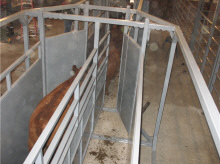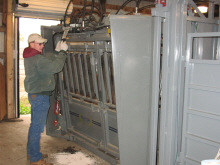



Livestock Handling System to Reduce Stress
A new livestock handling system that has been designed and installed at the North Dakota State University Carrington Research Extension centre has been proven to reduce stress on both the cattle and the workers.Cattle experts at North Dakota State University’s Carrington Research Extension centre designed the indoor livestock handling system with a system of steel pens and alleys to allow workers to direct cattle more easily from holding pens into a scale and/or the squeeze chute for weighing, treatment or vaccinations.
 |
| Cattle pass through the double alley that's part of the NDSU Carrington Research Extension centre's new livestock handling system. |
The design has be shown to be less stressful on the cattle because they move in a more natural flow pattern, according to centre animal scientist Vern Anderson. It is also less stressful for the cattle handlers because it requires less work to get the animals into the chute. A third advantage is that it makes the job of the handlers safer.
The handling system has another advantage of reducing the number of workers needed to move the cattle and hence increases productivity.
“Cows go through the alley and chute on their own,” said Dale Burr, a centre livestock technician.
“No one has to be back forcing them through.”
The system also has space saving advantages, making better use of the space in the centre’s 40-foot by 64-foot working barn.
“Previous to this renovation, the space was not well-utilized,” Anderson says.
“With this new system, we can work cattle with one or two fewer people with the same or better productivity.”
The system consists of three sequential holding pens and a “Bud box” from which cattle enter a double alley, then move into a single alley. From there, they move on to the single-animal scale and then the squeeze chute. Workers can sort the cattle into multiple pens after they exit the squeeze chute.
The Bud box, named after its creator, Bud Williams of Bowie, Texas, is a rectangular corral, rather than the traditional half-round “tub” crowding area. It is positioned to allow cattle to follow their natural movement behaviour as they pass into the double alley.
“The Bud box and double alley are the critical parts that make the system work so well,” Anderson said.
“Animals move into the double alley more easily than a single alley, with open side-by-side lanes creating less stress when other animals are close by.”
 |
| NDSU Carrington Research Extension centre livestock technician operates the hydraulics on the squeeze chute. |
Anderson, Burr, centre research specialist Breanne Ilse and centre livestock technician Tim Schroeder developed the new livestock handling system last summer with help from Tim Olson, a South Dakota livestock handling expert.
The centre’s previous system had been in place since 1972 and it violated current livestock-handling principles. For Anderson and his design team, finding a better system was imperative.
“We weigh a lot of cattle and we weigh cattle often,” he said.
“There are some commercial livestock handling systems on the market that require considerably more space, but our limited dimensions of the working barn required a custom design,” he added.
“This is not an extravagant system, but it is highly functional and user-friendly.”
Mr Schroeder added: “Cows love it. The people working the cattle also like the system.”
The system has centre-opening hydraulic gates on both ends of the single-animal scale. That feature reduces labour and stress on animals and workers during weighing because the centre-opening gates allow only one animal through at a time. Traditional roll gates take awhile to move across an opening, which occasionally can allow more than one animal through at a time.
“This individual animal scale is an essential piece of equipment for the research conducted at the centre,” Anderson said.
The hydraulic squeeze chute is another important component of the new system, he says. It operates quietly and holds cattle in place, which is useful when providing animals with special care or treatment.
Anderson said the new system also had an unexpected benefit of contributing to the success of area livestock operations.
Dave Heinrich, a cow-calf producer from Adrian, checked out the system while he was at the centre for a meeting. He said he liked what he saw, so he incorporated some of the concepts into his livestock handling facilities.
R and B Manufacturing, Steele, built and installed all but the hydraulic squeeze chute part of the centre’s new system. The chute was a gift from the North Dakota Corn Utilization Council.


